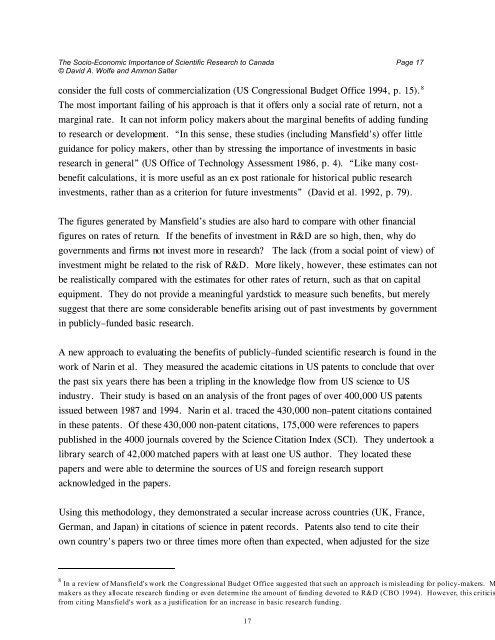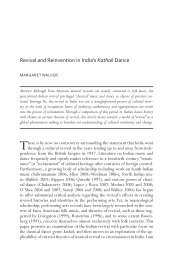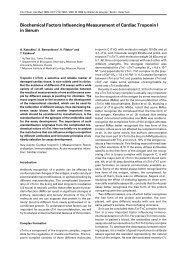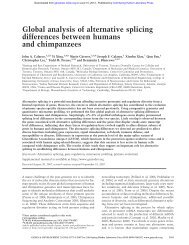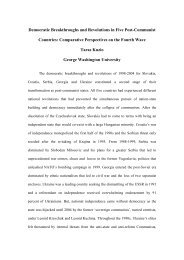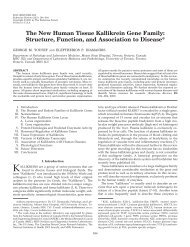The Socio-Economic Importance of Scientific Research To Canada
The Socio-Economic Importance of Scientific Research To Canada
The Socio-Economic Importance of Scientific Research To Canada
You also want an ePaper? Increase the reach of your titles
YUMPU automatically turns print PDFs into web optimized ePapers that Google loves.
<strong>The</strong> <strong>Socio</strong>-<strong>Economic</strong> <strong>Importance</strong> <strong>of</strong> <strong>Scientific</strong> <strong>Research</strong> to <strong>Canada</strong> Page 17© David A. Wolfe and Ammon Salterconsider the full costs <strong>of</strong> commercialization (US Congressional Budget Office 1994, p. 15). 8<strong>The</strong> most important failing <strong>of</strong> his approach is that it <strong>of</strong>fers only a social rate <strong>of</strong> return, not amarginal rate. It can not inform policy makers about the marginal benefits <strong>of</strong> adding fundingto research or development. “In this sense, these studies (including Mansfield's) <strong>of</strong>fer littleguidance for policy makers, other than by stressing the importance <strong>of</strong> investments in basicresearch in general” (US Office <strong>of</strong> Technology Assessment 1986, p. 4). “Like many costbenefitcalculations, it is more useful as an ex post rationale for historical public researchinvestments, rather than as a criterion for future investments” (David et al. 1992, p. 79).<strong>The</strong> figures generated by Mansfield’s studies are also hard to compare with other financialfigures on rates <strong>of</strong> return. If the benefits <strong>of</strong> investment in R&D are so high, then, why dogovernments and firms not invest more in research? <strong>The</strong> lack (from a social point <strong>of</strong> view) <strong>of</strong>investment might be related to the risk <strong>of</strong> R&D. More likely, however, these estimates can notbe realistically compared with the estimates for other rates <strong>of</strong> return, such as that on capitalequipment. <strong>The</strong>y do not provide a meaningful yardstick to measure such benefits, but merelysuggest that there are some considerable benefits arising out <strong>of</strong> past investments by governmentin publicly–funded basic research.A new approach to evaluating the benefits <strong>of</strong> publicly–funded scientific research is found in thework <strong>of</strong> Narin et al. <strong>The</strong>y measured the academic citations in US patents to conclude that overthe past six years there has been a tripling in the knowledge flow from US science to USindustry. <strong>The</strong>ir study is based on an analysis <strong>of</strong> the front pages <strong>of</strong> over 400,000 US patentsissued between 1987 and 1994. Narin et al. traced the 430,000 non–patent citations containedin these patents. Of these 430,000 non-patent citations, 175,000 were references to paperspublished in the 4000 journals covered by the Science Citation Index (SCI). <strong>The</strong>y undertook alibrary search <strong>of</strong> 42,000 matched papers with at least one US author. <strong>The</strong>y located thesepapers and were able to determine the sources <strong>of</strong> US and foreign research supportacknowledged in the papers.Using this methodology, they demonstrated a secular increase across countries (UK, France,German, and Japan) in citations <strong>of</strong> science in patent records. Patents also tend to cite theirown country's papers two or three times more <strong>of</strong>ten than expected, when adjusted for the size8 In a review <strong>of</strong> Mansfield's work the Congressional Budget Office suggested that such an approach is misleading for policy-makers. Mmakers as they allocate research funding or even determine the amount <strong>of</strong> funding devoted to R&D (CBO 1994). However, this criticisfrom citing Mansfield's work as a justification for an increase in basic research funding.17


